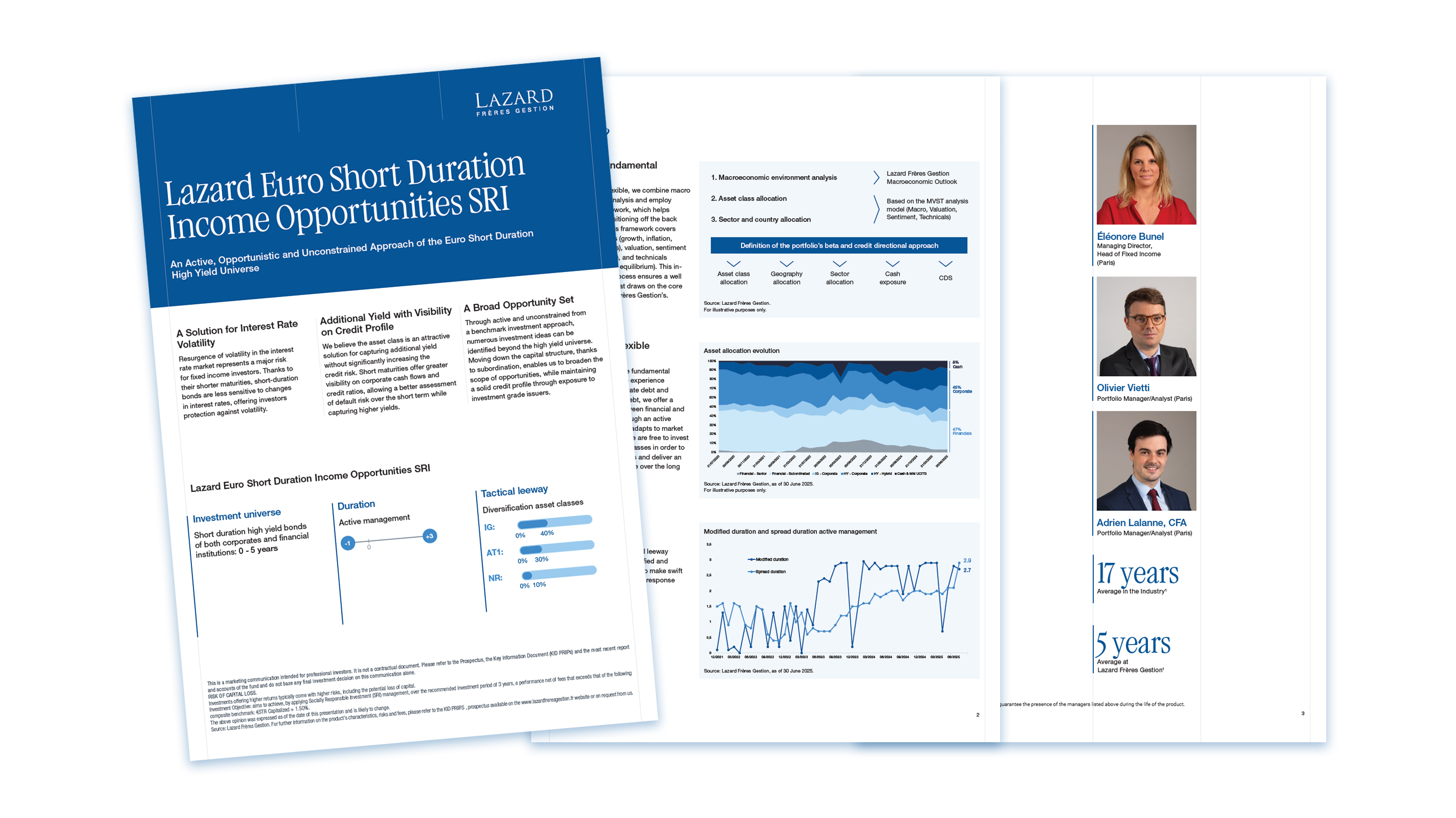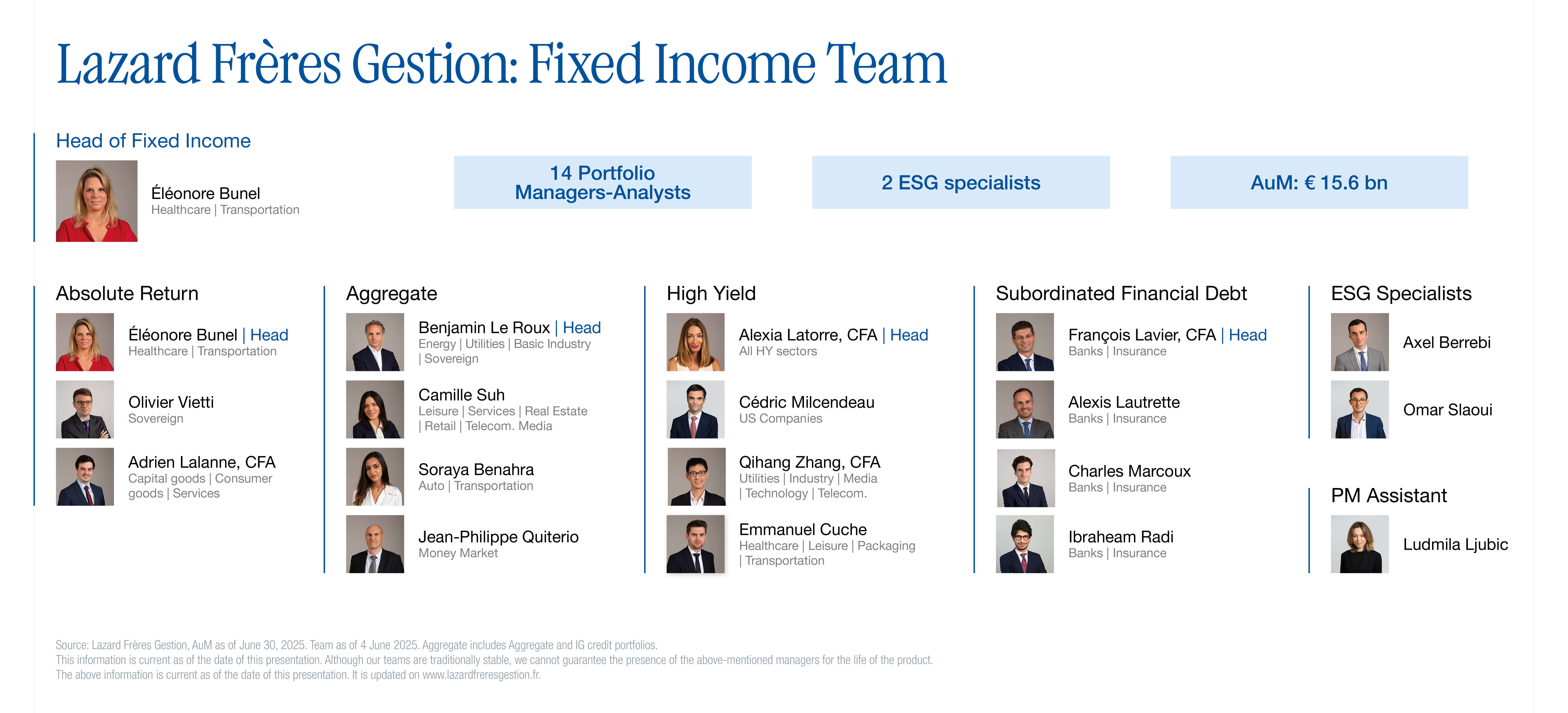This is a financial promotion and is not intended to constitute investment advice.
Lazard Credit Opportunities is a sub-fund of the SICAV Lazard Fund (Société d’investissement à capital variable) authorised and regulated as UCITS by the Autorité des marchés financiers and managed by Lazard Frères Gestion SAS.
Lazard Global Green Bond Opportunities is a sub-fund of the SICAV Lazard Fund (Société d’investissement à capital variable) authorised and regulated as UCITS by the Autorité des marchés financiers and managed by Lazard Frères Gestion SAS.
Lazard Global Bond Opportunities is a sub-fund of the SICAV Lazard Fund (Société d’investissement à capital variable) authorised and regulated as UCITS by the Autorité des marchés financiers and managed by Lazard Frères Gestion SAS.
Copies of the full Prospectus, the Key Information Document (DIC PRIIPS) for retail and insurance investment products (Reglementation PRIIPs) and the latest Reports and Accounts in French and, where applicable, other languages, are available on request from the address below or at www.lazardfreresgestion.fr. Existing and potential investors are asked to read and take note of the risk warnings in the prospectus and DIC. Investment decisions should be based on a review of all fund documentation, and final investment decisions should not be made based solely on this communication. Further information on the sustainability of the fund is available at the above web address. Lazard Fund Managers Limited/Lazard Frères Gestion reserves the right to withdraw this fund from the market at any time without notice.
The funds are actively managed.
Subscriptions should be based on the current prospectus. The returns on your investment may be affected by variations in exchange rates between the Fund's reference currency, the currency of the Fund's investments, your unit class and your home currency. The information provided in this document should not be construed as a recommendation or solicitation to buy, hold or sell any security. Nor should it be assumed that an investment in these securities has been or will be profitable. The tax treatment of each client may vary, and you are advised to consult a professional tax advisor. If you have any queries, please contact the LAM or LFG office in your country. Contact details are given below. The contents of this document are confidential and must be disclosed only to the persons for whom it is intended.
FOR THE EXCLUSIVE USE OF FINANCIAL PROFESSIONALS
Please note that not all share classes are registered for distribution in every jurisdiction. Investment into the portfolio will not be accepted before the appropriate registration is completed in the relevant jurisdiction.
United Kingdom, Finland, Ireland, Denmark, Norway and Sweden: The information is approved, on behalf of Lazard Fund Managers (Ireland) Limited, by Lazard Asset Management Limited, 20 Manchester Square, London, W1U 3PS. Incorporated in England and Wales, registered number 525667. Lazard Asset Management Limited is authorised and regulated by the Financial Conduct Authority.
Germany and Austria: Lazard Asset Management (Deutschland) GmbH, Neue Mainzer Straße 75, 60311 Frankfurt am Main is authorized and regulated in Germany by the BaFin. The Paying Agent in Germany is Landesbank Baden-Württemberg, Am Hauptbahnhof 2, 70173 Stuttgart, the Paying Agent in Austria is UniCredit Bank Austria AG, Rothschildplatz 1, 1020 Vienna.
Belgium and Luxembourg: This information is provided by the Belgian Branch of Lazard Fund Managers Ireland Limited, at Blue Tower Louise, Avenue Louise 326, Brussels, 1050 Belgium. The Paying Agent and the Representative in Belgium for the registration and the receipt of requests for issuance or repurchase of units or for switching sub-funds for Irish funds is ABN AMRO Bank NV, Belgian Branch, Roderveldlaan 5 bus 4, 2600 Berchem Belgium and for French funds is RBC Investor Services Bank S.A : 14, Porte de France, L-4360 Esch-sur-Alzette– Grand Duché de Luxembourg.
France: Any person requiring information in relation to the Fund mentioned in this document is required to consult the KIID which is available on request from Lazard Frères Gestion SAS. The information contained in this document has not been independently verified or audited by the statutory auditors of the UCITS(s) concerned. This information is provided by Lazard Frères Gestion SAS , 25, rue de Courcelles 75 008 Paris.
Italy: This information is provided by the Italian branch of Lazard Asset Management (Deutschland) GmbH. Lazard Asset Management (Deutschland) GmbH Milano Office, Via Dell'Orso 2 - 20121 Milan is authorized and regulated in Germany by the BaFin. Not all share classes of the relevant sub-fund are registered for marketing in Italy and target institutional investors only. Subscriptions may only be based on the current prospectus. The Paying Agent for the Irish funds are BNP Paribas Securities Services, Piazza Lina Bo Bardi, 3, 20124 Milano, and Allfunds Bank SA, Milan Branch, Via Santa Margherita 7, 20121, Milano. The Paying Agent for the French funds are Société Générale Securities Services, Via Benigno Crespi, 19, 20159 Milano, and BNP Paribas Securities Services, Piazza Lina Bo Bardi, 3, 20124 Milano.
Netherlands: This information is provided by the Dutch Branch of Lazard Fund Managers (Ireland) Limited, which is registered in the Dutch register held with the Dutch Authority for the Financial Markets (Autoriteit Financiële Markten).
Spain and Portugal: This information is provided by the Spanish Branch of Lazard Fund Managers Ireland Limited, at Paseo de la Castellana 140, Piso 10, Letra E, 28046 Madrid and registered with the National Securities Market Commission (Comisión Nacional del Mercado de Valores or CNMV) under registration number 18. The Fund is a Foreign Collective Investment Scheme registered with the CNMV.
Switzerland and Liechtenstein: Lazard Asset Management Schweiz AG, Uraniastrasse 12, CH-8001 Zurich. The representative in Switzerland is ACOLIN Fund Services AG, Leutschenbachstrasse 50, CH-8050 Zurich, the Paying Agent is Banque Cantonale de Genève, 17, quai de l’Ile, CH-1204 Geneva. For further information please visit our website, contact the Swiss representative or visit www.fundinfo.com. The paying agent in Liechtenstein is LGT Bank AG, Herrengasse 12, FL-9490 Vaduz. Not all share classes of the respective sub-fund are registered for distribution in Liechtenstein and are aimed exclusively at institutional investors. Subscriptions may only be made on the basis of the current prospectus. The performance shown does not take account of any commissions and costs charged when subscribing to and redeeming shares.











